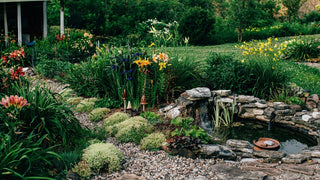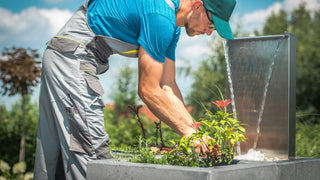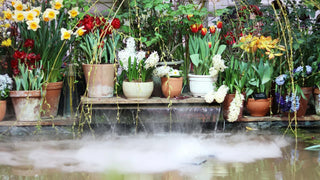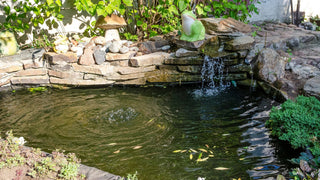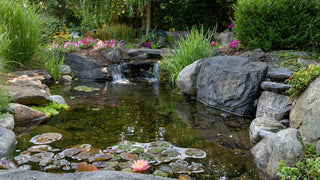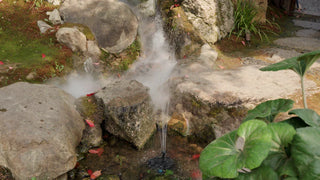
Ask any water feature owner what's keeping their water feature alive, and most will point squarely to the pump. It's not glamorous—you don't even realize it's there until something malfunctions—but without it, the water stagnates, oxygen levels plummet, and the whole pond seems lifeless. The wrinkle? A shallow water feature installation pump isn't the same unit as a deep water pump. Depth really does make all the difference.
If you’ve ever struggled with weak flow in a patio bowl or found that your waterfall barely trickles when installed on a deeper pond, you’ve already experienced what happens when the wrong pump is chosen. That’s why pond pump selection deserves more attention than it usually gets.
Different Needs in Shallow and Deep Ponds
Shallow water warms quickly, de-oxygenates quickly, and fills with suspended particles like pollen, flower petals, and dust. For these setups, you don't want the pump to be extremely powerful. What you really need is consistent, soft action at the surface--enough to break the water into little ripples and keep it from getting green. A small solar fountain pump will do.

Deep ponds stratify, though. The surface looks fine, but a foot or two below can be low on oxygen. No turnover, fish lie low and lethargic, and algae blooms reign supreme. A deep water pump has to pull water up from the low-oxygen zones and run it back in the direction of the surface. That means more lift capacity, more volume, and a design that can run around the clock without burning out.
Keep in mind the comparison of this: shallow water needs an ongoing "stir," while deep water demands a bottom-to-top blend.
Pump Performance Comparison
When shopping for specs, it's easy to become enamored with numbers. Three are the most crucial:
- Flow rate: Stated in gallons per hour (GPH). A small patio pond or bowl could be happy with 80–100 GPH. A backyard pond is generally happy with 200–300 GPH, and a big koi pond could need 600 or more.
- Lift height (head): This number shows the height the pump will lift water. If you just want a bubbling fountain in a shallow pool, low head is fine. For a waterfall or deeper circulation, you'll require 8–10 feet of lift at least.
- Power source: Solar pumps are perfect for wildlife ponds, balcony bowls, or small gardens--simple, quiet, and eco-friendly. For larger features or full-time waterfalls, AC-powered pumps or solar systems with higher wattage are the better choices.
Briefly, a shallow pond job pump can be small, lightweight, and solar-powered. A deep water pump has to put head height and flow first.
Where Each Pump Fits
- Balcony bowls and patio miniature features: These require only a small solar fountain with replaceable nozzles. It maintains the surface active without splashing water all over.
- Garden ponds that are about two feet deep: Solar pumps of mid-range with a battery backup work best here, providing sufficient circulation for plants and a small filter box.
- Deep ponds or koi setups: You’ll need a stronger deep water pump--something with a high lift and robust flow, capable of running a filter or powering a waterfall without choking.
- Decorative ponds with a waterfall edge: The pump must handle both depth and the extra push to lift water up to the spillway.
Matching the pump to the scenario makes life easier, reduces maintenance, and keeps fish and plants healthier.
Poposoap Range Recommendations
Poposoap offers pumps across each range, all with simplicity of use and eco-friendly performance in mind:
- For bird baths and small ponds: A Poposoap Solar Fountain Pump or Mini Water Garden Kit. These provide gentle bubbling and easy weekly cleaning.
- For small to medium ponds: A 12-watt solar fountain pump with battery backup. Ample flow for modest waterfalls and filters, and even on overcast days, reliable.
- For larger ponds: A 20-watt solar fountain pump or AC-powered Pond Filter Kit. These can handle higher GPH and lift, best for circulation and filtration in larger systems.
- For filtration-oriented systems: Poposoap Pond Filter Kits with biological media and pads. These keep the water clear while the pump pushes oxygen into the system.
This scale makes pond pump selection easier: shallow =small solar, mid-depth =mid-range with battery back-up, deep =more watts or AC back-up.
What Users Say
Installing Poposoap pumps, users often remark on how much difference it made in selecting the proper match:
- A balcony owner with a small ceramic bowl said that the solar fountain "took two minutes to install and hasn't needed anything but a wipe on the panel.".
- A garden owner who has a three-foot pond stated that the middle-range solar pump "continues to circulate water through the filter even after sunset utilizing the battery pack."
- An owner of a koi pond with a larger-watt pump reported fish movement picked up and water was clearer once the lower levels started circulating properly.
The consensus in reviews is this: the pumps are simple to install, quiet-running, and do their job when well-suited to the depth of the pond.
Final Thoughts
Depth matters more than most pondkeepers realize. A pump for shallower pond setups just needs to disturb the surface and cope with light particles. A deep water pump must move the entire column, sometimes in addition to delivering a filter or a waterfall. Knowing your pond's size, depth, and purpose makes selecting a pond pump a whole lot simpler.
Poposoap's AC and solar solutions both ends of the spectrum covered, giving you useful tools to keep your water feature in top working order. Choose your option, and your pond will reward you with sparkling water, active fish, and that soothing living sound of running water as soon as you step outside.



